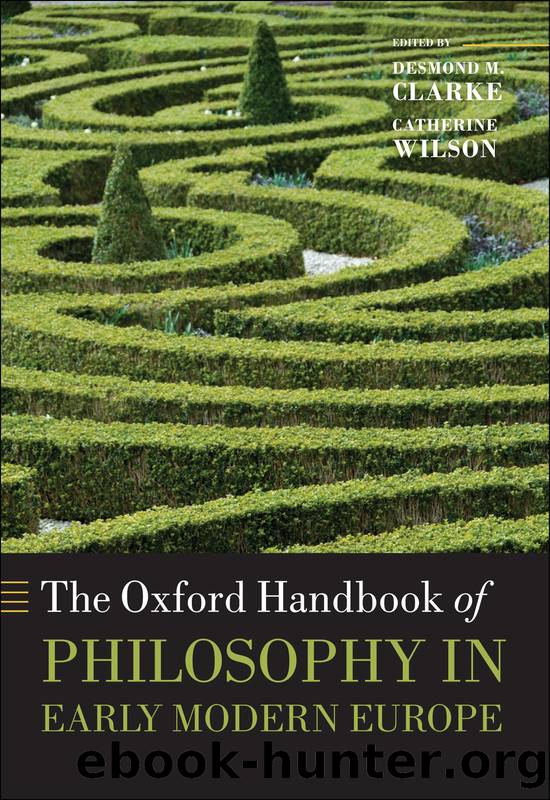The Oxford Handbook of Philosophy in Early Modern Europe by Desmond M. Clarke;Catherine Wilson;

Author:Desmond M. Clarke;Catherine Wilson;
Language: eng
Format: epub
Publisher: OUP Premium
Published: 2011-03-15T00:00:00+00:00
IV: NOTATION AND NEW NUMBERS
One notable feature of this history is the role of notation. Leibniz was very aware of the value of good notation, which makes it possible to see at a glance the way in which a designated entity is composed of (and hence related to) other simpler entities. He experiments not just with the use of letters as abbreviations, but also with the use of variables, both free and bound, as in his notation for infinitesimal calculus, in his analysis situs (early topology) as well as in his logic. The development of the theory of rational mechanics, and of algebraic methods to accompany it, to the point where it could be readily understood and used, depended on the development of good notation for dealing with ratios, proportions, equations, and functions. Once there is a notation that reflects arithmetic operations on magnitudes and the relations between them, it becomes natural to wonder whether every term permissibly formed actually designates a number. This is one route to the extension of the concept of number from integers, to negative as well as positive integers, to fractions (rational numbers) and to real and imaginary numbers. However, so long as number is conceived as the measure of some magnitude (whether discrete or continuous) these extensions are not unproblematic. How can there be a negative amount of something? The square root of an area is a line length (the side of a square with that area), but what is the square root of a line length?
Euclidâs Elements contains two treatments of proportion. Book V deals with proportions of magnitudes in general (the theory often attributed to Eudoxus), whereas Book VII deals with proportions between numbers. Book X covers incommensurable magnitudes. All of these topics were thus traditionally positioned as belonging to the geometry of lines, planes, and solids (lengths, areas, and volumes) and for this reason it was traditionally presumed that no sense could be given to anything more than a magnitude raised to the third power (the cube of a line length yields a volume). Moreover, the fact that there seemed to be two treatments of proportion in the Elements generated confusion and sparked controversy from the Renaissance through the seventeenth century.
One can appreciate the importance of a transparent notation when trying to follow the reasoning of a famous Renaissance author, Cardano, whose Great Art or the Rules of Algebra was published in 1545. The work provides methods for solving cubic and biquadratic equations among other things, and Cardano was aware that there could be negative and irrational solutions and even solutions involving the square roots of negative quantities. However, he lacked a notation; his work is mainly conducted in words and geometric diagrams, with little use of symbols. For example:
Download
This site does not store any files on its server. We only index and link to content provided by other sites. Please contact the content providers to delete copyright contents if any and email us, we'll remove relevant links or contents immediately.
The remains of the day by Kazuo Ishiguro(8347)
Tools of Titans by Timothy Ferriss(7748)
Giovanni's Room by James Baldwin(6760)
The Black Swan by Nassim Nicholas Taleb(6729)
Inner Engineering: A Yogi's Guide to Joy by Sadhguru(6413)
The Way of Zen by Alan W. Watts(6263)
Asking the Right Questions: A Guide to Critical Thinking by M. Neil Browne & Stuart M. Keeley(5326)
The Power of Now: A Guide to Spiritual Enlightenment by Eckhart Tolle(5299)
The Six Wives Of Henry VIII (WOMEN IN HISTORY) by Fraser Antonia(5202)
Astrophysics for People in a Hurry by Neil DeGrasse Tyson(4980)
12 Rules for Life by Jordan B. Peterson(4146)
Housekeeping by Marilynne Robinson(4025)
The Ethical Slut by Janet W. Hardy(4015)
Skin in the Game by Nassim Nicholas Taleb(3948)
Double Down (Diary of a Wimpy Kid Book 11) by Jeff Kinney(3884)
Ikigai by Héctor García & Francesc Miralles(3838)
The Art of Happiness by The Dalai Lama(3825)
Skin in the Game: Hidden Asymmetries in Daily Life by Nassim Nicholas Taleb(3704)
Walking by Henry David Thoreau(3663)
